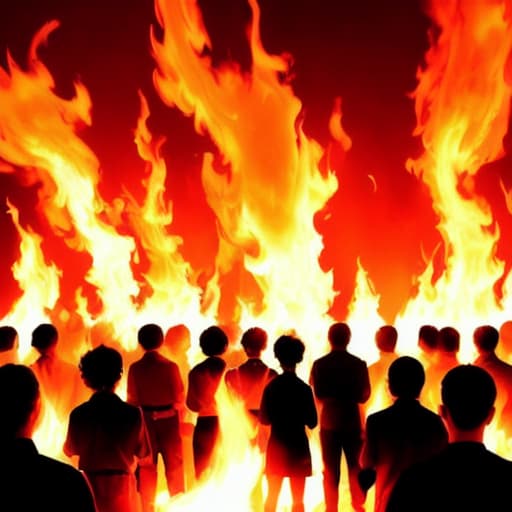On the Souls of Non-Human Creatures
First, it’s important to understand that there are two types of souls: those with eternal life, and those whose existence ends with the life they inhabit.
Let’s begin by looking at the latter—souls that last only for a single lifetime.
Every living creature in this world possesses a soul.

However, for non-human beings, their souls disappear once their physical bodies cease functioning—that is, when they die.
These are what we refer to as “souls limited to a single lifetime.”
You may have heard the term “soul continuity,” but this type of soul does not possess such continuity.
In other words, the memories and experiences of one lifetime are not passed on to the next generation.
Each life begins entirely from scratch, making it impossible for these souls to build upon past experiences.
To address this limitation, the Creator, Jehovih, provided a form of salvation for these non-human souls.
That is: non-human creatures are born with the instinctive knowledge they need to survive.
(This is explained in OAHSPE, Book of Sethantes, Chapters 7–9.)
For example, a tiger instinctively knows how to hunt without being taught.
It understands from birth how to use its fangs and physical strength.
Birds, likewise, can fly without needing to be instructed.
On the other hand, animals like chickens, which lack the ability to fly, will never be able to do so, no matter how hard they try.
This instinctive behavior is a fundamental characteristic of non-human souls.
On the Soul of Human Beings
Unlike animals, human souls possess what is called “soul continuity.”
In other words, even after the physical body ceases to function (i.e., at death), the soul does not disappear. Instead, it ascends to the heavens and can later reincarnate into a new physical body.
Through this cycle—rising to the heavens after death, reincarnating into a new life, and dying again—humans are said to repeat the process eternally.

However, in order for reincarnation to take place, the soul must first ascend to the spiritual realms. This initial ascension leads the soul into the lower heavens connected to Earth. No reincarnation can begin without this step, which is why it is referred to in OAHSPE as the “First Resurrection.”
After completing this first resurrection, the soul resides in the heavenly realm for a time, receiving education and participating in various kinds of labor.
Souls that became tainted during their physical lives undergo re-education in order to grow in spiritual rank.
In other words, people who lived immorally in the physical world are corrected in the afterlife, and their souls are gradually elevated.
Once a soul reaches a sufficient spiritual level and receives permission to reincarnate, it is assigned to a physical body at the moment of conception—when the fetus forms in the mother’s womb.
This moment is referred to as the “Second Resurrection.”
You may have heard the word “abortion.”
From the perspective of OAHSPE, abortion is considered a form of killing—because it ends the life of a soul that has finally been granted the opportunity to reincarnate.
Therefore, it should not be taken lightly.
In this way, human beings live their earthly lives while going through repeated cycles of the First and Second Resurrections.
This ongoing cycle of reincarnation is what OAHSPE calls “soul continuity.”
But were humans always equipped with soul continuity from the beginning?
The process by which the human soul became stable and enduring is described in OAHSPE, Book of God’s Word, Volume 21, Chapter 18, Verses 4–12.
According to this text, in the very early stages of humanity, most souls vanished shortly after death.
Only about 1% of souls were capable of reincarnating.
However, over the course of many generations, this gradually changed.
By around 4000 B.C., nearly 90% of souls born on Earth were said to have attained eternal life.
| Era | Time Period | Total Souls (hundreds of millions) | Eternal Souls (hundreds of millions) | (%) | Perishable Souls (hundreds of millions) | (%) |
|---|---|---|---|---|---|---|
| Early Stage of Humanity | 1 | 99 | ||||
| Before the Sinking of Pan | 1240 | 260.4 | 21 | 979.6 | 79 | |
| Cycle of Aph | B.C.22000~B.C.19000 | 660 | 356.4 | 54 | 303.6 | 46 |
| Cycle of Sue | B.C.19000~B.C.16000 | 870 | 539.4 | 62 | 330.6 | 38 |
| Cycle of Apollo | B.C.16000~B.C.13000 | 800 | 576 | 72 | 224 | 28 |
| Cycle of Thor | B.C.13000~B.C.10000 | 880 | 748 | 85 | 132 | 15 |
| Cycle of Osire | B.C.10000~B.C.7000 | 910 | 791.7 | 87 | 118.3 | 13 |
| Cycle of Fragapatti | B.C.7000~B.C.4000 | 920 | 828 | 90 | 92 | 10 |
🔍 Notes:
- Eternal Souls: Souls that achieved continuity and were eligible for reincarnation.
- Perishable Souls: Souls that vanished after death and could not reincarnate.
- This data reflects the spiritual evolution of humanity according to OAHSPE, showing how the proportion of souls capable of eternal progression increased dramatically over time.
On the Nature of Hell
Once a soul has attained eternal life, it can no longer “die.”
Because of this, if such a soul were to fall into hell, it would continue to suffer the torment of spiritual fire indefinitely—unless it is rescued.
In essence, hell is a kind of gathering place for souls who remain attached to the physical world even after death.

For example, imagine someone who killed many people during their lifetime. The souls of those who were killed often remain filled with resentment. They linger in the spirit world, waiting for the killer’s soul to arrive after death.
Once the perpetrator dies and becomes a spirit, the victims begin to exact their revenge—often with intense and relentless fury.
When many such cycles of resentment and revenge overlap, they form a kind of spiritual mass or “knot.”
As these knots connect with other knots, they grow into larger clusters—eventually forming what is known as hell.
It is said that once such a hell is created, it will continue to exist unless it is dissolved by the intervention of higher spiritual beings—gods or divine administrators.
To avoid being trapped in such a place, it is essential to let go of attachments to the physical world, approach death with a peaceful heart, and strive not to cause resentment in others.
Ultimately, living with compassion and awareness is the best way to avoid becoming entangled in the chains of spiritual suffering.
References, Images used
| Books | authors | publishers |
|---|---|---|
| OAHSPE ”A New Bible in the Worlds of Jehofih and His angel embassadors.” | John B. Newbrough | OAHSPE PUBLISHING ASSOCIATION |
Image:Generated from stable diffusion(model:etherRealMix_etherRealMix4.safetensors)
Image:Generated from stable diffusion(model:XSMerge-RealisticVisionV3-ForArchi)



コメント